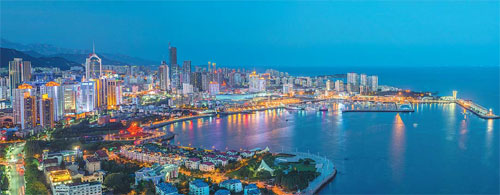Coastal City plans to be Belt and Road hub
Despite the complicated economic situation, Qingdao, a coastal city in Shandong province, reported strong economic growth in the 12th Five-Year Plan period (2011-15).
The city's GDP was 930 billion yuan ($142.42 billion) in 2015, up from 566.6 billion yuan in 2011. The average growth rate over the five years was 9.7 percent, according to the 2016 government work report released on Feb 18.
The average year-on-year growth of total retail sales of consumer goods of Qingdao was 13.6 percent, reaching 371.4 billion yuan.
The unemployment rate in Qingdao is less than 4 percent.
Over the five years of the 12th Five-Year Plan period, the city recorded outstanding results in innovation, development of its marine economy, financial service reform, infrastructure construction, improved livelihoods and opening-up.
Innovation
"Expenditure on research and development accounted for 2.81 percent of Qingdao's GDP in 2015, up from 2.2 percent in 2011," said Zhang Xinqi, the city's mayor.
Zhang said the city had a total of 908 city-level or above key laboratories, company-owned technological centers and engineering technology research centers by the end of 2015, while the number of technology-driven companies jumped from 289 in 2011 to 964 in 2015.
In all, 17 R&D bases developed by State-owned companies and research institutions such as the Chinese Academy of Sciences are in operation. Ten domestic leading universities, including Tsinghua University and Harbin Engineering University, have established R&D centers in Qingdao.
Marine economy
Development of its marine economy has been a key focus for Qingdao over the last five years.
The city mapped out three key marine economy zones: the Blue Silicon Valley, the West Coast New Economic Zone and the Hongdao Economic Zone.
The Blue Silicon Valley is a world-class research and development base for marine science and technology. Twelve important research platforms are under construction in the valley.
"It will strongly support Qingdao's marine economy development," Zhang said.
The West Coast New Economic Zone, a national-level zone, features several industrial parks in different fields.
The Hongdao Economic Zone is designed to be a center for high-tech companies.
Financial service reform
Qingdao obtained approval from the State Council to establish the Qingdao Wealth Management Financial Comprehensive Reform Pilot Area, the country's only wealth management financial zone in February 2014.
The move allows the city to establish a diversified portfolio of wealth management institutions and a multifunctional wealth management market.
A total of 56 financial institutions have established branches in the zone.
By the end of 2015, 57 companies were listed on the National Equities Exchange and Quotations, the so-called New Third Board, and 318 companies were listed on the Qingdao Blue Ocean Equity Exchange, a locally operated equity exchange market.
Qingdao is striving to be a hub city connecting the Silk Road Economic Belt and 21st Century Maritime Silk Road. It has developed six national-level economic parks and four special customs supervision zones to strengthen its trade and communication with other markets.
Qingdao's accumulative actual use of foreign capital during the 12th Five-Year Plan period was $26.53 billion, about 1.8 times more than the previous plan period. The total export and import volume between 2011 and 2015 was $372.5 billion, according to the government work report.
Infrastructure construction made some key breakthroughs between 2011 and 2015, as projects such as Jiaozhou Bay Undersea Tunnel and Jiaozhou Bay Bridge were put into operation. The newly developed port and the airport that is under development will better serve the city in upcoming years.
The city also introduced a variety of different measures to improve the livelihoods of local residents over the past five years, and the total expenditure on residents' livelihoods was 331.5 billion yuan, including the upgrading and building of 969 kindergartens and 729 primary and secondary schools.
The 13th Five-Year Plan
Qingdao plans to develop the city into a regional hub for innovation, high-end services and marine economy to support local economic growth over the next five years.
The city aims to have an average annual GDP growth rate of above 7.5 percent and an average growth rate of above 7.5 percent for residents' disposable incomes, Zhang said.
"The city's expenditure on research and development will increase to 3.2 percent of Qingdao's GDP," he said.
The Qingdao government will also continue to invest in advanced marine science and try to make breakthroughs in core technology research to support the Belt and Road Initiative. It will accelerate its construction of marine-related industrial parks and will invest 120 billion yuan on 140 related projects in the next five years.
Qingdao will also continue to increase the service sector's proportion of the economy to support its economic restructuring over the next five years. The sector is expected to contribute 57 percent of Qingdao's GDP in the 13th Five-Year Plan period (2016-20).
zhuanti@chinadaily.com.cn
|
A bird's eye view of the beautiful port city of Qingdao at night. Zhang Xiao / for China Daily |



















